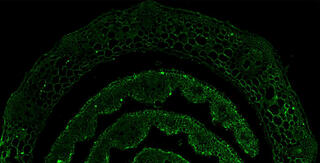Regulation of plant cell wall sugar deposition

Identification of genes involved in plant cell wall polysaccharide production and restructuring
The Science
With the goal of ultimately engineering bioenergy crops to accumulate large amounts of easily digestible sugars, researchers from the Great Lakes Bioenergy Research Center (GLBRC) have identified a transcription factor that is highly co-expressed with the major mixed-linkage glucan (MLG) synthase gene in the model grass Brachypodium distachyon. Characterization of downstream genes regulated by this transcription factor provides insight into the mechanism of MLG production and restructuring, information vital to overcoming known growth defects associated with MLG synthase overexpression.
The Impact
Identification of genes involved in the production and restructuring of mixed-linkage glucan (MLG), an easily digestible six-carbon sugar, should lead to a better understanding of how plants store MLG in their cell walls. With such information, GLBRC researchers aim to engineer bioenergy crops like sorghum to accumulate large amounts of MLG in the stem without disrupting plant growth.
Summary
Mixed-linkage glucan (MLG) is an energy-rich polysaccharide found at high levels in some grass endosperm cell walls and at lower amounts in other tissues. Cellulose synthase-like F (CSLF) and cellulose synthase-like H (CSLH) genes synthesize MLG, but it is unknown if other genes participate in the production and restructuring of MLG. Working with the model grass Brachypodium distachyon, GLBRC researchers identified a trihelix family transcription factor (BdTHX1) that is highly co-expressed with the BdCSLF6 gene and which appears to help regulate MLG biosynthesis. They showed that BdTHX1 protein can bind with high affinity to BdCSLF6 as well as BdXTH8, which encodes a grass-specific endotransglucosylase, an enzyme involved in cell wall structuring. BdXTH8 was found to preferentially interact with MLG and xyloglucans, suggesting it may mediate their binding in plant tissues. In addition, B. distachyon shoots grown from cells overexpressing BdTHX1 showed abnormal growth and early death. These results indicate that the transcription factor BdTHX1 likely plays an important role in MLG biosynthesis and restructuring by regulating the expression of BdCSLF6 and BdXTH8. This knowledge will be instrumental for engineering the bioenergy grass sorghum to accumulate large amounts of MLG in its stem tissue.
Contacts
Principal Investigator
Curtis Gene Wilkerson
wilker13@msu.edu
BER Program Manager
Kent Peters, Ph.D.
Biological Systems Sciences Division
Office of Biological and Environmental Research
Office of Science
Department of Energy
Kent.Peters@science.doe.gov
Funding
This work was supported by the U.S. Department of Energy Great Lakes Bioenergy Research Center (grant no. BER DE-FC02-07ER64494 and DE-SC0018409) and the UK Biotechnology and Biological Sciences Research Council (BBSRC; grant no. BB/N002458/1).
Publications
Fan, M. et al. “A trihelix family transcription factor is associated with key genes in mixed-linkage glucan accumulation.” Plant Physiology 178, 1207-1221 (2018) [DOI: 10.1104/pp.18.00978].
Related Links
http://www.plantphysiol.org/content/178/3/1207